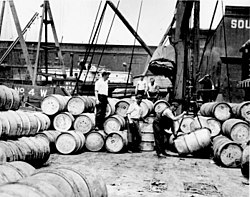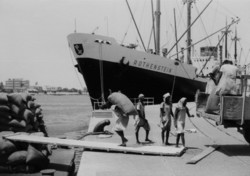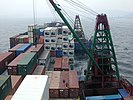Dockworker


A dockworker (also called a longshoreman, stevedore, or docker) is a waterfront manual laborer who loads and unloads ships.[1]
As a result of the intermodal shipping container revolution, the required number of dockworkers has declined by over 90% since the 1960s.[2]
Etymology
[edit]The word stevedore (/ˈstiːvɪˌdɔːr/) originated in Portugal or Spain, and entered the English language through its use by sailors.[3] It started as a phonetic spelling of estivador (Portuguese) or estibador (Spanish), meaning a man who loads ships and stows cargo, which was the original meaning of stevedore (though there is a secondary meaning of "a man who stuffs" in Spanish); compare Latin stīpāre meaning to stuff, as in to fill with stuffing. In Ancient and Modern Greek, the verb στοιβάζω (stivazo) means pile up.[4][5] In Great Britain and Ireland, people who load and unload ships are usually called dockers; in Australia, they are called stevedores, dockworkers or wharfies; and, in the United States and Canada, the term longshoreman, derived from man-along-the-shore (or alongshore + man), is used.[6][7] Before the extensive use of container ships and shore-based handling machinery in the United States, longshoremen referred exclusively to the dockworkers, while stevedores, part of a separate trade union, worked on the ships operating their cranes and moving cargo.
History
[edit]Dockworkers, also known as longshoremen and stevedores, have existed since ancient times. The role of dockworkers has evolved significantly over the centuries as maritime trade has grown and modernized:
- Ancient times: The Phoenicians, Greeks, and Romans all relied on dockworkers to load and unload cargo from ships at port cities such as Carthage, Athens, and Ostia.[8][9][10][11]
- Medieval period: In the Middle Ages, dockworkers played a crucial role in the trade networks of Europe. The Hanseatic League, a powerful trading confederation in Northern Europe, employed dockworkers to handle goods at major ports like Lübeck and Bruges.[12]
- Industrial Revolution: The Industrial Revolution brought steam-powered ships and railways, leading to increased trade volumes and the need for more efficient handling of cargo. Dockworkers organized into unions to protect worker rights and improve working conditions, leading to the formation of organizations such as the International Longshoremen's Association in the United States.[13]
- Containerization: The latter 20th century saw the introduction of containerization, which revolutionized the shipping industry by standardizing how goods were transported, leading to faster turnaround times and increased efficiency. Dockworker use declined by 90%, with those remaining principally operating heavy machinery such as cranes.[14][15] A dramatic increase in global trade was seen, a result of improved technology and liberalized trade treaties. [16]
Loading and unloading ships
[edit]| Admiralty law |
|---|
| History |
| Features |
| Contract of carriage/Charterparty |
| Parties |
| Judiciaries |
| International conventions |
| International organizations |
Loading and unloading ships requires knowledge of the operation of loading equipment, the proper techniques for lifting and stowing cargo, and the correct handling of hazardous materials. In addition, workers must be physically strong and able to follow orders attentively. Many longshoremen are needed to unload a ship. A ship can only be at a port for a limited amount of time, so their work must be completed quickly.
In earlier days before the introduction of containerization, men who loaded and unloaded ships had to tie down cargoes with rope. A type of stopper knot is called the stevedore knot. Securely tying up parcels of goods is called stevedore lashing or stevedore knotting. While loading a general cargo vessel, they use dunnage, which are pieces of wood (or nowadays sometimes strong inflatable dunnage bags) set down to keep the cargo out of any water that might be lying in the hold or are placed as shims between cargo crates for load securing.
Today, the vast majority of non-bulk cargo is transported in intermodal containers.[17] The containers arrive at a port by truck, rail, or another ship and are stacked in the port's storage area. When the vessel that will be transporting them arrives, the containers it is offloading are unloaded by a crane. The containers either leave the port by truck or rail or are stored until they are placed on another ship. Once the ship is offloaded, the containers it leaves with are brought to the dock by truck. A crane lifts the containers from the trucks onto the ship. As the containers pile up on the ship, the workers connect them to the vessel and the other already-placed containers. The jobs involved include the crane operators, the workers who connect the containers to the ship and each other, the truck drivers who transport the containers from the dock and storage area, the workers who track the containers in the storage area as they are loaded and unloaded, as well as various supervisors. Those workers at the port who handle and move the containers are likely to be considered stevedores or dockworkers.
Before containerization, freight was often handled with a longshoreman’s hook, a tool which became emblematic of the profession (mainly on the west coast of the United States and Canada).[18]
Traditionally, stevedores had no fixed job but would arrive at the docks in the morning seeking employment for the day. London dockers called this practice standing on the stones,[19] while in the United States, it was referred to as shaping up or assembling for the shape-up.[20][21]
Dock workers have been a prominent part of the modern labor movement.[22]
- Container handling in Hong Kong – 2005
-
At anchor, two barges with cranes (floating derricks) at port
-
A container is lifted from the deck.
-
Dockworkers on the containers in the ship's hatch
-
Strong tidal current, loading work in adverse conditions
Notable dockworkers
[edit]This section needs additional citations for verification. (April 2021) |
Former stevedores and dockworkers include:
- Crispus Attucks – American patriot
- Harry Bridges – founder of the International Longshore and Warehouse Union (ILWU)
- Joey Coyle – basis for the movie Money for Nothing
- Jack Dash – British dock workers' trade union leader
- Peter Fraser – Prime Minister of New Zealand (1940-1949)
- Danny Greene – American mobster
- Patrick Joseph "P.J." Kennedy – American businessman and grandfather of 35th U.S. President John F. Kennedy
- Tom Mann – British trade unionist and organizer of the London Dock Strike of 1889
- Peter MacKay – Canadian former government minister and conservative party leader (a stevedore for two summers while a teenager)[23]
- Bruce Nelson – labor historian, author of Workers on the Waterfront
- Benito Quinquela Martín – painter from Buenos Aires, Argentina. His works reflect the work at the docks in La Boca, a portuary district of Buenos Aires.
- Stan Weir – blue-collar intellectual and sociologist, founder of Singlejack Press
- Artie Lange Actor & Comedian worked on the Orange Juice docks before entering show business.
In popular culture
[edit]- In 1949, reporter Malcolm Johnson was awarded a Pulitzer Prize for a 24-part investigative series titled Crime on the Waterfront, published in the New York Sun.
- The material from Malcolm Johnson's investigative series was fictionalized and used as a basis for the influential film On the Waterfront (1954), starring Marlon Brando as a longshoreman, and the working conditions on the docks figure significantly in the film's plot. On the Waterfront was a critical and commercial success that received twelve Academy Award nominations and won eight, including Best Picture, Best Actor for Brando, Best Supporting Actress for Eva Marie Saint, and Best Director for Elia Kazan. The American Film Institute ranked it the 8th-greatest American movie of all time in 1997 and 19th in 2007.[24]
- Playwright Arthur Miller was involved in the early stages of the development of On the Waterfront; his play A View from the Bridge (1955) also deals with the troubled life of a longshoreman.[25]
- In season 2 of the HBO series The Wire, which first aired in 2003, the Stevedore Union and its members working in Baltimore, particularly Frank Sobotka, figure prominently in the second season's story.[26][27]
See also
[edit]- 1913 Sligo Dock strike
- Admiralty law
- Battle of Ballantyne Pier (Canada)
- Dockers Union (disambiguation)
- Dunnage
- Federated Ship Painters and Dockers Union
- History of Squamish and Tsleil-Waututh longshoremen, 1863–1963
- International Longshore and Warehouse Union (United States)
- Liverpool dockers' strike (1995–98) (UK)
- Mersey Docks and Harbour Company
- Mudlark
- National Union of Dock Labourers
- Scottish Union of Dock Labourers
- Teamster
- Weeks Marine
References
[edit]- ^ "Dockworker". Dictionary.com. Retrieved August 27, 2023.
- ^ Khan, Khalil U. (15 September 2014). "Stevedoring & The Role of Stevedores in Shipping". The International Institute of Marine Surveying (IIMS). Retrieved 7 April 2021.
- ^ David Maclachlan (1875). A Treatise on the Law of Merchant Shipping. W. Maxwell & Son. pp. 387–.
- ^ "Modern Greek Verbs – στοιβάζω, στοίβαξα, στοιβάχτηκα, στοιβαγμένος – I pile up". moderngreekverbs.com.
- ^ "Stevedores – definition of stevedores by The Free Dictionary". TheFreeDictionary.com.
- ^ "America on the Move collection". Archived from the original on June 12, 2007.
- ^ Harper, Douglas. "longshoreman (n.)". Online Etymology Dictionary. Retrieved 1 October 2024.
- ^ Hazzard, Shirley (2008). The Ancient Shore: Dispatches from Naples.
- ^ Horejs, Barbara (2003). Ports of Trade: Al Mina and Geometric Greek Pottery in the Levant.
- ^ Casson, Lionel (1959). The Ancient Mariners: Seafarers and Sea Fighters of the Mediterranean in Ancient Times.
- ^ Casson, Lionel (1994). Seafaring in Ancient Times.
- ^ Meier, Dirk (October 15, 2009). Seafarers, Merchants, and Pirates in the Middle Ages.
- ^ "The position of dockers and sailors in 1897 and the International Federation of Ship, Dock and River Workers". www.marxists.org. Retrieved 2024-02-14.
- ^ "Labor on the Waterfront". South Street Seaport Museum. Retrieved 2024-02-14.
- ^ "The ILWU Story". ILWU. Retrieved 2024-02-14.
- ^ Kim, Kap Hwan; Günther, Hans-Otto, eds. (2007). Container Terminals and Cargo Systems: Design, Operations Management, and Logistics Control Issues. Springer.
- ^ Marc Levinson (2006). The Box, How the Shipping Container Made the World Smaller and the World Economy Bigger. Princeton Univ. Press. ISBN 0-691-12324-1.
- ^ "Uniform Containerization of Freight: Early Steps in the Evolution of an Idea". Business History Review. 43 (1): 84–87. 1969. doi:10.2307/3111989. JSTOR 3111989. S2CID 246479077.
- ^ Standing on the Stones BFI Film and TV Database, London Dockers (1964)
- ^ "shape-up". Dictionary.com. Random House Unabridged Dictionary. Retrieved 2008-05-15.
- ^ Blum, Howard (March 13, 1978). "The 'Shape-Up' on Piers Gives Way to 'Show- Up'". The New York Times. Retrieved 2019-10-13.
- ^ "British History in depth: Banners of the British Labour Movement". BBC.
- ^ MacKay, Peter (August 25, 2012). "Peter MacKay learned to appreciate Arctic life working as a stevedore". National Post. Retrieved March 13, 2023.
- ^ Rapf, Joanna E. (2003). On the Waterfront. Cambridge University Press.
- ^ Epstein, Arthur D. (1965). "A Look at A View from the Bridge". Texas Studies in Literature and Language. 7 (1): 109–122.
- ^ Warren, Kenneth W. (2011). "Sociology and The Wire". Critical Inquiry. 38 (1): 200–207. doi:10.1086/661649. S2CID 161316328.
- ^ Herbert, Daniel (2012). "'It Is What It Is': The Wire and the Politics of Anti-Allegorical Television Drama". Quarterly Review of Film and Video. 29 (3): 191–202. doi:10.1080/10509200903120047. S2CID 155014315.
Further reading
[edit]- Arnesen, Eric (1994). Waterfront Workers of New Orleans: Race, Class, and Politics, 1863–1923.
- Connolly, Michael C. (2010). Seated by the Sea: The Maritime History of Portland, Maine, and Its Irish Longshoremen. University Press of Florida.
- Callebert, Ralph (2017). On Durban's Docks: Zulu Workers, Rural Households, Global Labor. University of Rochester Press.
- Davis, Colin J. (2003). Waterfront Revolts: New York and London Dockworkers, 1946–61.
- Land, Isaac (2007). "Liberty on the Waterfront: American Maritime Culture in the Age of Revolution". Journal of Social History. 40 (3): 731–743. doi:10.1353/jsh.2007.0051. S2CID 143564724.
- Mello, William J. (2010). New York Longshoremen: Class and Power on the Docks.
- Nelson, Bruce (1990). Workers on the Waterfront: Seamen, Longshoremen, and Unionism in the 1930s.
- Parnaby, Andrew (2008). Citizen Docker: Making a New Deal on the Vancouver Waterfront, 1919–1939.
- Phillips, Jim (2005). "Class and Industrial Relations in Britain: The 'Long' Mid-century and the Case of Port Transport, 1920–70" (PDF). Twentieth Century British History. 16 (1): 52–73. doi:10.1093/tcbh/hwi009.
- Safford, Jeffrey J. (2008). "The Pacific Coast Maritime Strike of 1936: Another View". Pacific Historical Review. 77 (4): 585–615. doi:10.1525/phr.2008.77.4.585.
- Vaughan Wilson, Matt (2008). "The 1911 Waterfront Strikes in Glasgow: Trade Unions and Rank-and-File Militancy in the Labour Unrest of 1910–1914". International Review of Social History. 53 (2): 261–292. doi:10.1017/S0020859008003441.
- Velasco e Cruz, Maria Cecília (2006). "Puzzling Out Slave Origins in Rio de Janeiro Port Unionism: The 1906 Strike and the Sociedade de Resistência dos Trabalhadores em Trapiche e Café". Hispanic American Historical Review. 86 (2): 205–245. doi:10.1215/00182168-2005-002.
- "Longshore Workers and Their Unions". Waterfront Workers History Project.




